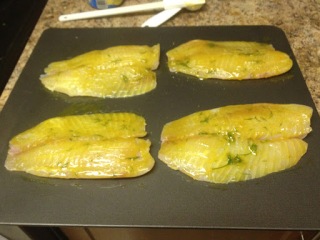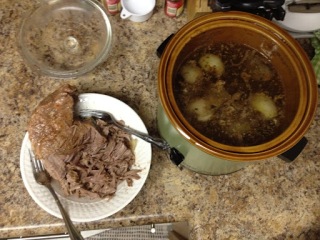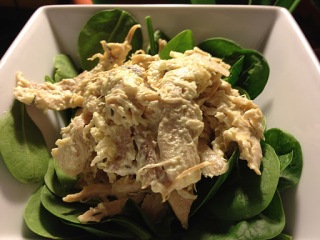So, instead, I chose to roast my own chopped tomatoes (…perhaps I should have diced them) and I made fresh salsa. Here’s more or less what I started with:
First, I roasted approximately 2 and 1/2 large tomatoes (they were actually left over from another recipe)…
While those were roasting, I turned on the crockpot to low and I worked on making a fresh salsa: 2-3 (small to medium sized) Roma tomatoes, some cilantro, fresh lime juice from half a lime, and 1 little red chili. It wasn’t my best salsa (in fact, my best and favorite to make is a pineapple-mango salsa, but that’s for another day). I had forgotten I’d need to make salsa from scratch and wasn’t prepared to do it; so that concoction was the best I could come up with given what I had in the house. I diced/blended it all really well in the Ninja.
Next, I sautéed 1 green bell pepper, 1 jalapeño and 1 onion (both of which received a quick pulse in our Ninja) with a splash of olive oil…
I put the homemade salsa and the onion-pepper mix into the crockpot. I didn’t put the roasted tomatoes in right away because I know they could overpower the overall dish, so I waited until the end to see how things turned out.
Then, I lightly browned about 2 lbs of ground beef with four good-sized cloves of garlic. We like are garlic, so the bigger the cloves the better. 😉 When that was ready, I strained out the excess grease and scooped the ground beef-garlic mix into the crockpot.
(It’s at this point that I would usually cook up 4 slices of bacon and 6 smallish sausages. But we haven’t found bacon or sausage that’s Whole30 friendly, so those didn’t go in this time.)
Brent then came over to help evaluate the situation. We agreed to add about half of the roasted tomatoes to the crock pot.
Next, he put in the spices. I almost always make the chili, but he always puts in the spices for me 🙂 Here’s what we used:
- 1 tbsp chipotle chili pepper
- 1 tsp cayenne pepper
- 1 tsp smoked paprika
- 1 tbsp chili powder.
We gave it a good stir and then let the crockpot sit overnight on low.










